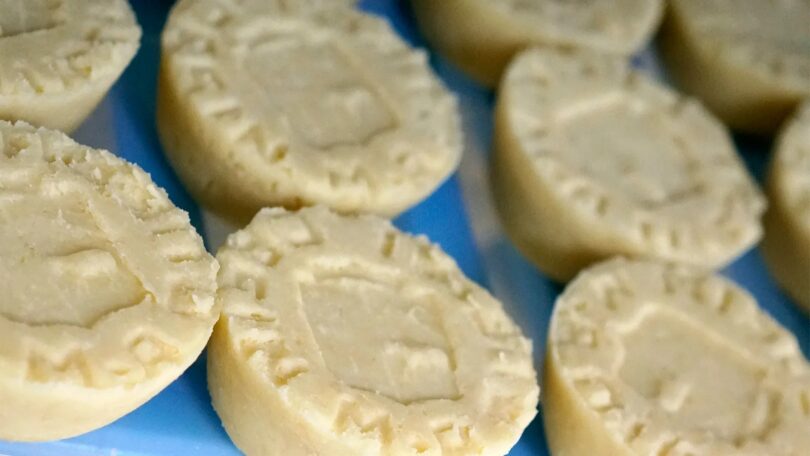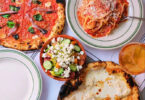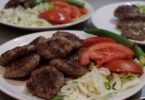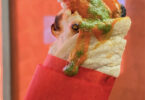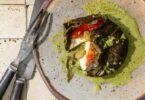Linni Kral
Spain’s northern coastline is the site of many dramas. The region, situated across the Bay of Biscay from France’s Brittany peninsula, is draped in a thick fog much of the year. Its rugged terrain begins at the water’s edge with the sheer cliffs and rocky beaches of the Cantabrian Sea, where you could be forgiven for thinking you were in the Hebrides. The scabrous landscape scales up from there, heading inland into the ever-craggier boulders of the Picos de Europa mountain range.
Until recent decades, the people living among these peaks were isolated from the region’s city centres; the twisting, hairpin road that now snakes through Aviles and Oviedo into the mountains was only just built in the latter half of the 20th Century. It was along this road that I first encountered Casín – a cheese, quite possibly Spain’s oldest, that’s been made in these mountains since at least the 14th Century. Today, only three Casín makers remain – and in a culinary landscape dominated by Manchego, its survival is an open question.
That winding road is called AS-117, and it leads from the Asturian city of Gijón to a small mountain town called Campo de Caso. It was here that, in late 2022, I found myself making cheese beside Natalia Alvarez at Queseria Redes, one of three surviving Casín producers. Natalia is the daughter of Marigel Alvarez, a woman famous in Asturias for bringing Casín back from the near-brink in the 1980s. She secured Protected Geographic Identification (IGP) and Protected Designation of Origin (DOP) for the cheese – regulations also used to protect the likes of Parmiggiano-Reggiano, Emmentaler and Comté. That you can now find Casín in Japan, Germany, Mexico and the US (not to mention Madrid) is Marigel’s handiwork.
I’ve been in the cheese industry for over a decade, and I’ve toured facilities in Spain, Italy, France, California and up and down the eastern American coastline. I’m familiar with the industry’s weirdest offerings – Sardinian casu marzu, which contains insect larvae; cheeses fermented with live mites or lichen; cheeses made with yak, deer, camel, llama, alpaca, donkey, horse and even human milk. Still, I had never seen anyone make cheese like the Alvarez women do and have not tasted anything quite like Casín before or since.
For how many cheeses there are in the world, it’s surprising how similar the inputs are for nearly all of them. You start with animal milk, add cultures, add a coagulant to separate the milk into curds and whey, then drain off the whey. The curds become your cheese – and what kind depends on what you do to them. Throughout history, recipes for classics like cheddar and mozzarella have been established through fine tweaks in timing and temperature, animal diet, milk type and aging.
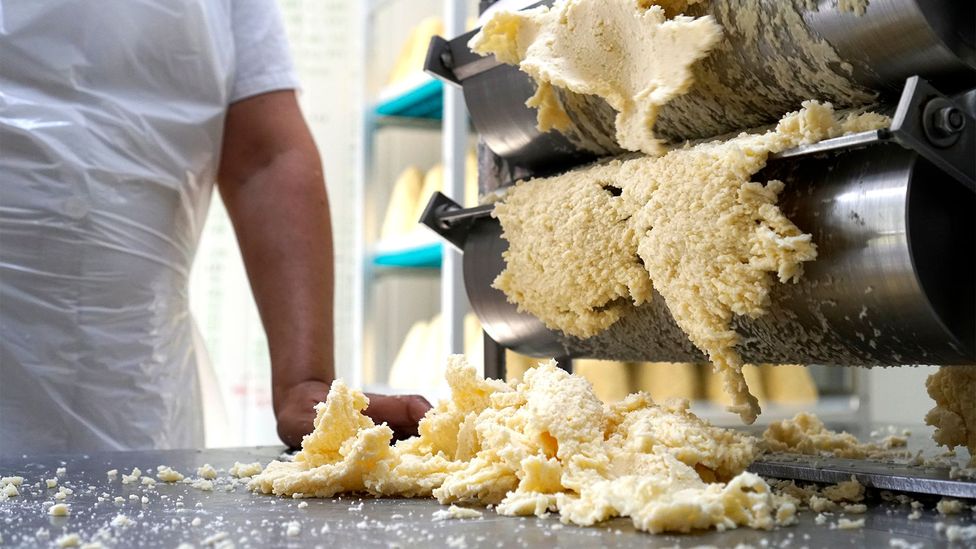
Dried cow’s milk curd is fed through a rabilar (Credit: Linni Kral)
Next to these standards, Casín might as well be an alien lifeform. It starts simply enough, with coagulated cow’s milk strained of its whey, then things get pretty weird. The curd is dried out in thick loaves that, over the course of seven days, get crusty at the corners and effervescent with holes. These spongy slabs are flipped as they rest, then fed through a machine called a rabilar, which looks like a cross between a pasta machine and a printing press. Curd spills out the other side in pale, butter-yellow sheets that resemble sugar cookie dough – and taste about as far from it as you can imagine. The milk for Casín is treated with cultures similar to those used in Provolone Piccante or Pecorino Romano, which produce a spicy, sharp compound known as butyric acid. Some people liken its flavour to baby’s breath; others, to baby vomit.
Between pressings, the increasingly dry and crumbly curd is salted and moulded by hand into lumpy, cones called gorollos. The cheesemaker tastes them as they go, deciding when it’s time to press again and when it’s time to hand-mould them into their final shape – a flat circle about the height of a thumb, wider at the top than the bottom, imprinted with a decorative relief stamp produced by local silversmiths and woodworkers. Natalia’s is metal and marked “NLA”, while her mother’s is wooden with “M.A.” and the shield of the Caso council carved into it. (This tradition dates back to when cheesemakers aged their wheels in communal hórreos – shared neighbourhood granary sheds that still dot the landscape of north-western Spain today.)
The final wheels of Casín are pungent – just being in the room with it can make your nose run. The flavour is tart and astringent; it triggered a genuine histamine reaction in most members of my group. “And it’s stronger the more times you pass it through,” Natalia told me, through a translator. I asked how many times she passes it through and I didn’t need help understanding her response: mucho. “This village likes it stronger,” she said.
How did Asturians arrive at this improvisational, knobby, nose-stinging cheese? Perhaps unsurprisingly, it starts with the cows. Casín is made with the milk of the Asturiana de la Montaña breed, fittingly nicknamed Casína. The Casína spend their days climbing the Picos de Europa range, where their small and agile bodies enable them to scamper about like goats. They’re a beef cow and produce very little milk, but what they do make is rich and fatty as a result of their nutrient-dense diet on high mountain pastures.
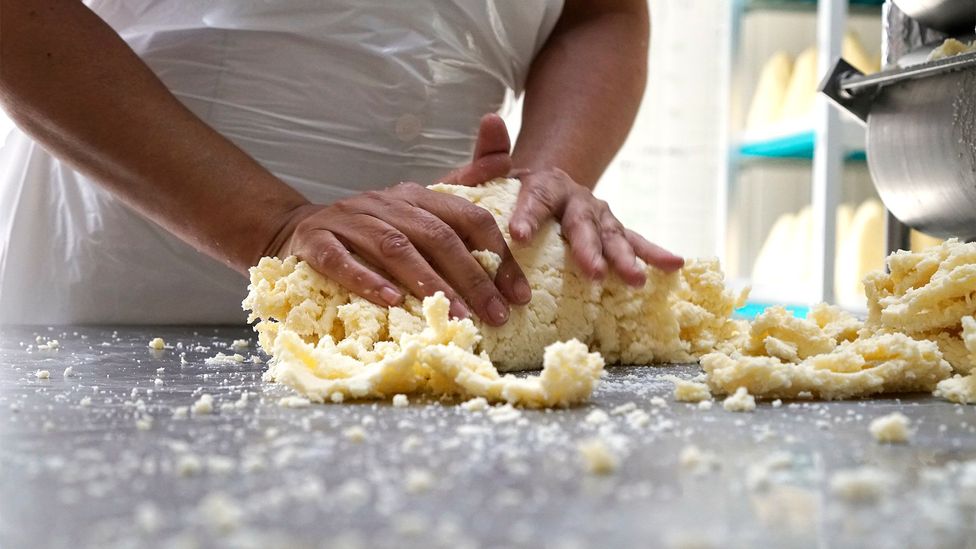
The curd is kneaded with salt between pressings in the rabilar (Credit: Linni Kral)
“In the past, cheese was made only when the cows calved and had milk left over,” Natalia told me. “This cheese had to last the whole year, so that during the months without milk we could count on this food.” The rabilar facilitates this long aging, removing moisture with each press to prevent mould growth.
And because of their isolation, modernity has had little impact on Casín production. Natalia’s father designed the makeshift stainless steel rabilar at Queseria Redes; the two other remaining producers (Queseria La Corte and Queseria Ca’ Llecho) use a meat grinder. Both machines are only shades removed from the old way, in which someone would sit at a small wooden table whose flat top held a roller on a hand crank. Most households only had two or three cows, but everyone had one of these tables in their house.
For a while in the 19th Century, house-made wheels were exported to Gijón, Oviedo and Madrid, but trade fell dramatically when the Spanish Civil War broke out. In the 1960s, rural depopulation depleted milk production as people left the mountains to make cider in the cities. By the time Marigel came around in the 1980s, Natalia told me, “Asturians had forgotten about this cheese jewel.”
Marigel learned how to make Casín from her mother-in-law. When the time came for her to take over the family business, she threw her weight into reviving it, establishing the DOP to define what “Casín” meant and supporting other producers in the area who wanted to start making the cheese. She was dubbed “Mayor Cheesemaker of Asturias” in 2005, and her Casín took the Outstanding Cheese Award at the Oviedo Ascension Fair in 2006. A cheese-tasting association recognised Casín as the best cheese in Asturias in 2010, and Marigel’s cheese took top honours at the first and second Casín DOP Cheese Contests held in 2015 and 2016.
But even with these honours, production has yet to take off. New cheesemakers are reluctant to try their hand at the style – Casína cows produce very little milk, and neither rabilars nor artisanally crafted stamps are available at supply shops. Even if they could get around material limitations, Casín’s intuitive and ad-hoc process requires a jazz-like adaptability that’s hard to teach newcomers. “Once they realise how difficult it can be,” Natalia said, “they choose another option, another cheese easier to produce.”
It was these very difficulties and fragile supply chains that made Casín eligible for inclusion in Slow Food’s Ark of Taste, which it joined in 2013. When Slow Food awards these designations, they’re looking for foods in serious danger of disappearing within a few generations. When I spoke to Slow Food board member Francesco Sottile, he likened each food in the Ark to a rivet in an airplane. “If we start removing rivets, for a while nothing will happen,” he said. “But little by little the structure will weaken and, at a certain point, removing just one more rivet will cause the plane to crash.”
When I asked Natalia Alvarez what would prevent Casín from disappearing, her answer surprised me: change it. “Bring it closer to the tastes of consumers,” she said. “Adapt to [their] tastes, offer them the same cheese with different levels of maturity.” A few years back, one of her customers requested “mas rabilar“. The extra aging caused the gorollos to grow blue mould, and a new cheese called Natalia Blue was born. (They took it to a gourmet trade show that first year and won.) They’re also developing a meltable roll of Casín for restaurant customers, instead of the traditional wheel.
But are these Casín? Traditional DOPs exist to ensure these types of changes don’t occur. Natalia and her mother play a big role in their DOP, though, and their openness to change has been instrumental in broadening the cheese’s scope. They partnered with Spanish distributor Queseria Cultivo in recent years in the hopes of reaching a wider global market.
Queseria Cultivo’s export manager Begoña Zorrilla Medio described Casín’s target audience as someone interested in how the environment affects flavour, and who understands the value of an ancestral cheese. “It is not a cheese for everyone,” she said. “And that in itself is an added value.”
Casín has always been about adaptability – about making do with what was around, about bobbing and weaving and tasting as you go. Perhaps the best way the Alvarez women can honour Casín’s true spirit is to explore what it can mean to different people, how it can change to suit modern tastes, how it can survive. The Alvarez family taking the temperature of their consumers is not unlike them testing their gorollos – only the cheesemaker knows when it’s ready.
Courtesy: BBC

